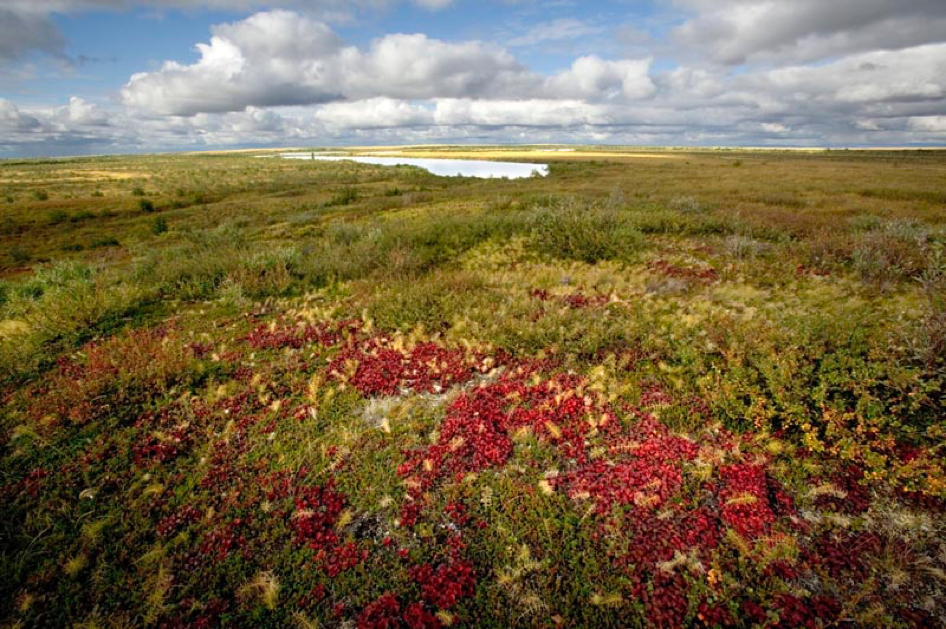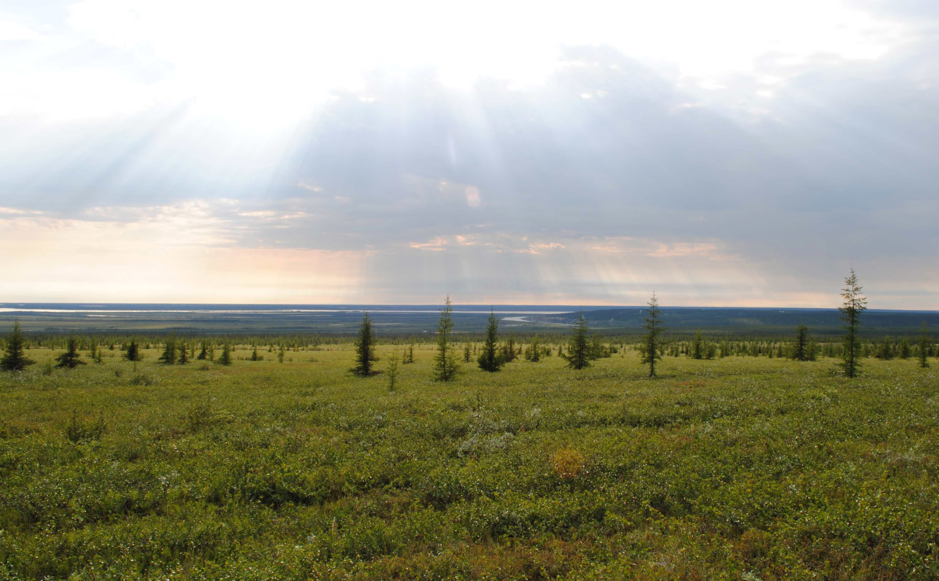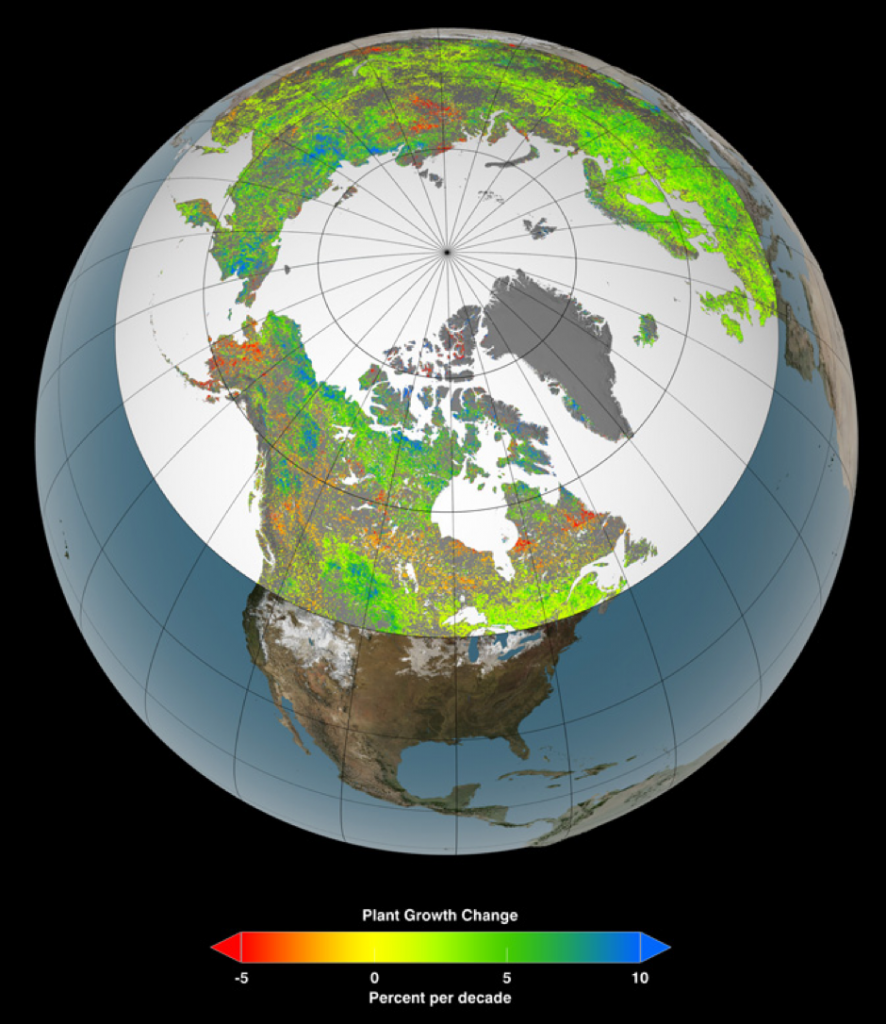As the 24-hour summer sun melts the long winter snow, a flush of green emerges from the cold, frozen landscape. In recent years unexpected visitors have migrated into the harsh environment that 50 years ago would have succumbed to the cold. Rising global temperatures and atmospheric carbon dioxide (CO2), particularly since the turn of the millennia, is allowing shrubs and spruce (Reid, n.d.) found further south in boreal forests to survive the new tundra conditions.

The effect of modern humans’ industrial activity discharging Carbon Dioxide (CO2) into the atmosphere has caused the average global temperature to rise 0.99 °C relative to 1951-1980 figures (NASA, 2017). Due to the nature of the environment, Arctic regions are more sensitive and experience the warming effect two to three degrees higher than the global average (Ramsayer, 2016).
The combination of increased CO2, higher temperatures, and subsequently longer growing seasons is in fact benefitting some vegetation. Satellite images have shown a 29.4 percent increase of greening in the far north of Russia, Scandinavia, Alaska and Canada where previously only limited vegetation could grow (Ramsayer, 2016). However, as with all dramatic changes there are winners and loser and many mosses and lichens have been declining.

There are multiple reasons for Arctic greening, one being increased temperature. When the temperature rises closer to its optimum growing temperature the rate of the chemical processes such a photosynthesis and enzymes function within the plant improves dramatically. The efficiency of photosynthesis (process of absorbing light energy to react with CO2 to produce sugars) improves because the quantity of photosynthetic pigments increases under warmer temperatures (Saxe et al., 2002). When exposed to temperatures above the optimum, it can cause proteins to become inactive, inhibiting CO2 fixation needed for photosynthesis (Shailes, 2013). This may be one of the reasons behind decline in the native mosses and lichens in the region.
Higher temperatures also create a longer growing season (previously 50-60 days) (Krajick, 2016) allowing the frozen soil to thaw. Species including Alder can now successfully compete as their seedlings are able to grow quickly allowing the roots to take hold and withstand frost cover at the end of the growing season.
Arctic Greening has also been influenced by rising CO2 acting as a fertiliser for plants in soils with a low moisture content. CO2 is a limiting factor in photosynthesis, with more readily available, photosynthesis can function more efficiently (Saxe et al., 2002). Studies have shown that plants have the ability to photosynthesise up to 40 percent faster when they are subjected to CO2 concentrations between 475 and 600ppm (Pearson et al., 2013).

Temperatures are expected to rise alongside CO2 concentrations, inevitably changing the structure of the Arctic region and enhancing the greening effect leading to further warming. This will cause further encroachment of the treeline and a decline in mosses and lichens which will in turn alter the ecosystem relationships and dynamics between plant and animal species (Pearson et al., 2013).
[493 words]
In Text References:
Krajick, K. (2016). Where Trees Meet Tundra, Decoding Signals of Climate Change. [Blog] State of the Planet. Available at: http://blogs.ei.columbia.edu/2016/11/16/where-trees-meet-tundra-decoding-signals-of-climate-change/ [Accessed 16 Mar. 2017].
NASA. (2017). Climate Change: Vital Signs of the Planet. [online] Available at: https://climate.nasa.gov/vital-signs/carbon-dioxide/ [Accessed 17 Mar. 2017]. [Accessed 18 Mar. 2017].
Pearson, R., Phillips, S., Loranty, M., Beck, P., Damoulas, T., Knight, S. and Goetz, S. (2013). Shifts in Arctic vegetation and associated feedbacks under climate change. Nature Climate Change, 3(7), pp.673-677.
Ramsayer, K. (2016). NASA Studies Details of a Greening Arctic. [Blog] NASA. Available at: https://www.nasa.gov/feature/goddard/2016/nasa-studies-details-of-a-greening-arctic [Accessed 20 Mar. 2017].
Reid, R. (n.d.). Explore the World’s Tundra. [online] National Geographic. Available at: http://www.nationalgeographic.com/environment/habitats/tundra-biome/ [Accessed 19 Mar. 2017].
Saxe, H., Cannell, M., Johnsen, Ø., Ryan, M. and Vourlitis, G. (2002). Tree and forest functioning in response to global warming. New Phytologist, 149(3), pp.369-399.
Shailes, S. (2013). It’s getting hot out here: the challenges facing plants in hot weather. [Blog] Plant Scientist. Available at: https://plantscientist.wordpress.com/2013/07/23/its-getting-hot-out-here-the-challenges-facing-plants-in-hot-weather/ [Accessed 16 Mar. 2017].
Image References:
Goldstone, H. (2013). Dramatically Greener Arctic in Near Future. [Blog] Capean Islands. Available at: http://capeandislands.org/post/new-research-predicts-dramatically-greener-arctic-near-future#stream/0 [Accessed 19 Mar. 2017].
Hansen, K., Cole, S. and Mariaire, R. (2013). NASA – Amplified Greenhouse Effect Shifts North’s Growing Seasons. [online] NASA. Available at: https://www.nasa.gov/topics/earth/features/growth-shift.html [Accessed 19 Mar. 2017].
NHPTV.org. (2017). Tundra. [online] Available at: http://www.nhptv.org/wild/tundra.asp [Accessed 21 Mar. 2017].
Recent Comments